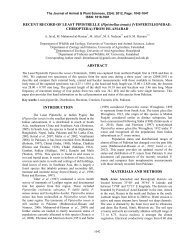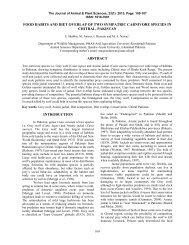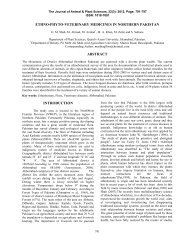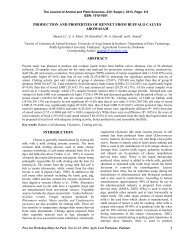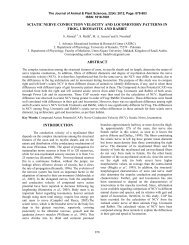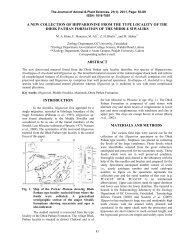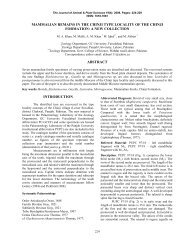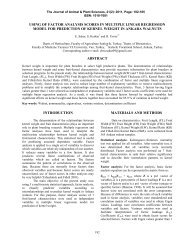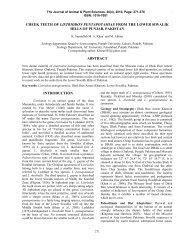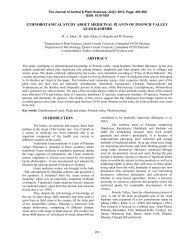enzymes in poultry nutrition abstract - Journal of Animal and Plant ...
enzymes in poultry nutrition abstract - Journal of Animal and Plant ...
enzymes in poultry nutrition abstract - Journal of Animal and Plant ...
You also want an ePaper? Increase the reach of your titles
YUMPU automatically turns print PDFs into web optimized ePapers that Google loves.
Khattak et al. J. Anim. Pl. Sci. 16(1-2): 2006<br />
ENZYMES IN POULTRY NUTRITION<br />
F. M. Khattak, T. N. Pasha * , Z. Hayat * <strong>and</strong> A. Mahmud<br />
Department <strong>of</strong> Poultry Production. * Department <strong>of</strong> <strong>Animal</strong> Nutrition<br />
University <strong>of</strong> Veter<strong>in</strong>ary <strong>and</strong> <strong>Animal</strong> Sciences, Lahore, Pakistan.<br />
ABSTRACT<br />
The biggest s<strong>in</strong>gle expense <strong>in</strong> any system <strong>of</strong> <strong>poultry</strong> production is feed account<strong>in</strong>g for up to 70% <strong>of</strong> total production cost<br />
per bird. Poultry naturally produces <strong>enzymes</strong> to aid the digestion <strong>of</strong> feed nutrients. However, they do not have enzyme to<br />
break down fibre completely <strong>and</strong> need exogenous <strong>enzymes</strong> <strong>in</strong> feed to aid digestion. This review covers the <strong>in</strong>formation<br />
on <strong>enzymes</strong> <strong>and</strong> their uses <strong>in</strong> <strong>poultry</strong> <strong>nutrition</strong>. Enzymes are biological catalyst composed <strong>of</strong> am<strong>in</strong>o acids with vitam<strong>in</strong>s<br />
<strong>and</strong> m<strong>in</strong>erals. They br<strong>in</strong>g about biochemical reactions without themselves undergo<strong>in</strong>g any change. The benefits <strong>of</strong> us<strong>in</strong>g<br />
<strong>enzymes</strong> <strong>in</strong> <strong>poultry</strong> diets <strong>in</strong>clude not only enhanced bird performance <strong>and</strong> feed conversion but also less environmental<br />
problems due to reduced output <strong>of</strong> excreta. In addition, this review demonstrates that <strong>enzymes</strong> are a very useful tool <strong>in</strong><br />
the study <strong>of</strong> physiological <strong>and</strong> metabolic mechanisms. Such studies will enhance our underst<strong>and</strong><strong>in</strong>g regard<strong>in</strong>g the role <strong>of</strong><br />
dietary <strong>enzymes</strong> <strong>in</strong> <strong>poultry</strong> <strong>nutrition</strong>. The <strong>in</strong>formation presented here serves to demonstrate the significant potential <strong>of</strong><br />
<strong>enzymes</strong> <strong>in</strong> <strong>poultry</strong> feeds.<br />
Key words: Poultry <strong>nutrition</strong>; enzyme supplementation.<br />
INTRODUCTION<br />
Feed<strong>in</strong>g <strong>enzymes</strong> to <strong>poultry</strong> is one <strong>of</strong> the major<br />
<strong>nutrition</strong>al advances <strong>in</strong> the last fifty years. It is the<br />
culm<strong>in</strong>ation <strong>of</strong> someth<strong>in</strong>g that <strong>nutrition</strong>ists realized for a<br />
long time but until 1980's it rema<strong>in</strong>ed beyond their reach.<br />
Indeed, the theory <strong>of</strong> feed <strong>enzymes</strong> is simple. <strong>Plant</strong>s<br />
conta<strong>in</strong> some compounds that either the animal cannot<br />
digest or which h<strong>in</strong>der its digestive system, <strong>of</strong>ten because<br />
the animal cannot produce the necessary enzyme to<br />
degrade them. Nutritionists can help the animal by<br />
identify<strong>in</strong>g these <strong>in</strong>digestible compounds <strong>and</strong> feed<strong>in</strong>g a<br />
suitable enzyme. These <strong>enzymes</strong> come from<br />
microorganisms that are carefully selected for the task<br />
<strong>and</strong> grown under controlled conditions (Wallis, 1996).<br />
The <strong>poultry</strong> <strong>in</strong>dustry readily accepts <strong>enzymes</strong> as<br />
a st<strong>and</strong>ard dietary component, especially <strong>in</strong> wheat <strong>and</strong><br />
barley-based rations. But still many questions are<br />
partially answered. For example, how do <strong>enzymes</strong> work?<br />
Do growth rates reflect differences <strong>in</strong> the potency <strong>of</strong><br />
different enzyme preparations? What is the l<strong>in</strong>k between<br />
gut viscosity, enzyme action <strong>and</strong> growth rates? <strong>and</strong> are<br />
<strong>enzymes</strong> necessary <strong>in</strong> all <strong>poultry</strong> rations?. This review<br />
article aims to supply some background <strong>in</strong>formation<br />
about enzyme <strong>and</strong> its usage <strong>in</strong> <strong>poultry</strong> <strong>nutrition</strong> <strong>and</strong> also<br />
help to answer some <strong>of</strong> commonly asked questions<br />
regard<strong>in</strong>g <strong>enzymes</strong>.<br />
Enzymes: Enzymes are one <strong>of</strong> the many types <strong>of</strong> prote<strong>in</strong><br />
<strong>in</strong> biological systems. Their essential characteristic is to<br />
catalyze the rate <strong>of</strong> a reaction but is not themselves<br />
altered by it. They are <strong>in</strong>volved <strong>in</strong> all anabolic <strong>and</strong><br />
catabolic pathways <strong>of</strong> digestion <strong>and</strong> metabolism.<br />
Enzymes tend to be very specific catalysts that act on one<br />
or, at most, a limited group <strong>of</strong> compounds known as<br />
substrates. Enzymes are not liv<strong>in</strong>g organisms <strong>and</strong> are not<br />
concerned about viability or cross <strong>in</strong>fection. They are<br />
stable at 80-85 degree centigrade for short time.<br />
Another important feature <strong>of</strong> <strong>enzymes</strong> is that the<br />
rate <strong>of</strong> an enzyme catalyzed reaction <strong>in</strong>creases with<br />
<strong>in</strong>creas<strong>in</strong>g substrate concentration, to the po<strong>in</strong>t where<br />
there is no further response <strong>and</strong> the enzyme is said to be<br />
saturated. Therefore, we need to match the amount <strong>of</strong><br />
enzyme with the quantity <strong>of</strong> substrate (Acamovic <strong>and</strong><br />
McCleary, 1996).<br />
It is common practice to name <strong>enzymes</strong> by add<strong>in</strong>g the<br />
suffix ase to the name <strong>of</strong> the pr<strong>in</strong>cipal substrate. For<br />
example, β-glucanase is an enzyme that splits β-glucans,<br />
<strong>and</strong> proteases break prote<strong>in</strong>. We may also broadly<br />
categorize the digestive <strong>enzymes</strong> as endogenous or<br />
exogenous - referr<strong>in</strong>g to those produced by the animal<br />
<strong>and</strong> those adm<strong>in</strong>istered from outside, respectively. For<br />
example, pancreatic lipase, which splits fat or lipid <strong>in</strong>to<br />
glycerol <strong>and</strong> fatty acids, is an endogenous enzyme. Those<br />
<strong>enzymes</strong> added to feed as a supplement are exogenous<br />
(Classen, 1996; Classen <strong>and</strong> Bedford, 1991).<br />
Sources <strong>of</strong> Enzymes: Enzymes were used <strong>in</strong> the<br />
preparation <strong>of</strong> foods long before there was any awareness<br />
<strong>of</strong> <strong>enzymes</strong> as such, possibly as long ago as 10,000 years.<br />
The <strong>in</strong>dustrial exploitation <strong>of</strong> microbial <strong>enzymes</strong> <strong>in</strong> the<br />
Western world started 100 years ago with the patent<strong>in</strong>g <strong>of</strong><br />
a process for the production <strong>of</strong> alpha-amylase (Taka<br />
m<strong>in</strong>e) from the fungus Aspergillus oryzae. Enzymes are<br />
produced <strong>in</strong> every liv<strong>in</strong>g organism from the highest<br />
developed animals <strong>and</strong> plants to the simplest unicellular<br />
forms <strong>of</strong> life, as they are essential for metabolic process.<br />
Most <strong>of</strong> the <strong>enzymes</strong> currently used <strong>in</strong> the food <strong>and</strong><br />
1
Khattak et al. J. Anim. Pl. Sci. 16(1-2): 2006<br />
beverage <strong>in</strong>dustry are from Aspergillus, but<br />
hemicellulases <strong>and</strong> cellulases are derived from<br />
Trichoderma. Recently, genes encod<strong>in</strong>g for different<br />
<strong>enzymes</strong>, <strong>in</strong>clud<strong>in</strong>g phytases, ß-glucanases, <strong>and</strong><br />
xylanases, have been cloned <strong>and</strong> expressed <strong>in</strong> different<br />
commercial systems (microorganisms <strong>and</strong> plants). It is<br />
possible to produce large amounts <strong>of</strong> cheap enzyme by<br />
cont<strong>in</strong>ually select<strong>in</strong>g favorable microbes, grow<strong>in</strong>g them<br />
<strong>in</strong> advanced fermentation systems <strong>and</strong> by streaml<strong>in</strong><strong>in</strong>g<br />
the extraction <strong>and</strong> purification <strong>of</strong> the enzyme (Wallis,<br />
1996).<br />
Microorganisms that generally <strong>in</strong>volved <strong>in</strong><br />
production <strong>of</strong> <strong>enzymes</strong> are; Bacteria (Bacillus subtilis,<br />
Bacillus lentus, Bacillus amyloliquifaciens <strong>and</strong> Bacillus<br />
stearothermophils), Fungus (Triochoderma<br />
longibrachiatum, Asperigillus oryzae <strong>and</strong> Asperigillus<br />
niger) <strong>and</strong> Yeast (S. cerevisiae)<br />
Enzymes <strong>in</strong> Poultry Nutrition: The use <strong>of</strong> <strong>enzymes</strong> <strong>in</strong><br />
animal feed is <strong>of</strong> great importance. Consistent <strong>in</strong>crease <strong>in</strong><br />
the price <strong>of</strong> feed <strong>in</strong>gredients has been a major constra<strong>in</strong>t<br />
<strong>in</strong> most <strong>of</strong> the develop<strong>in</strong>g countries. As a consequence<br />
cheaper <strong>and</strong> nonnconventional feed <strong>in</strong>gredients have to<br />
be used which conta<strong>in</strong> higher percentage <strong>of</strong> Non-Starch<br />
Polysaccharides (soluble <strong>and</strong> <strong>in</strong>soluble/crude fibre) along<br />
with starch. Non Starch Polysaccharides (NSPs) are<br />
polymeric carbohydrates which differ <strong>in</strong> composition <strong>and</strong><br />
structure from starch (Morgan et al., 1995) <strong>and</strong> possess<br />
chemical cross l<strong>in</strong>k<strong>in</strong>g among them therefore, are not<br />
well digested by <strong>poultry</strong> (Adams <strong>and</strong> Pough, 1993;<br />
Annison, 1993). A part <strong>of</strong> these NSPs is water-soluble<br />
which is notorious for form<strong>in</strong>g a gel like viscous<br />
consistency <strong>in</strong> the <strong>in</strong>test<strong>in</strong>al tract (Ward, 1995) thus by<br />
reduc<strong>in</strong>g gut performance. Predom<strong>in</strong>antly water soluble<br />
the other h<strong>and</strong>, ß-glucans adversely affect all nutrients,<br />
especially prote<strong>in</strong> <strong>and</strong> starch utilization <strong>and</strong> are known to<br />
give rise highly viscous conditions <strong>in</strong> the small <strong>in</strong>test<strong>in</strong>e<br />
<strong>of</strong> the chicks (Hasselman <strong>and</strong> Aman, 1986).<br />
Poultry do not produce <strong>enzymes</strong> for the<br />
hydrolysis <strong>of</strong> Non-Starch Polysaccharide present <strong>in</strong> the<br />
cell wall <strong>of</strong> the gra<strong>in</strong>s <strong>and</strong> they rema<strong>in</strong> un-hydrolyzed.<br />
This results <strong>in</strong> low feed efficiency. Research work has<br />
suggested that the negative effects <strong>of</strong> NSPs can be<br />
overcome by dietary modifications <strong>in</strong>clud<strong>in</strong>g<br />
supplementation <strong>of</strong> diets with suitable exogenous enzyme<br />
preparations (Creswell, 1994). Enzymes break down the<br />
NSPs, decreases <strong>in</strong>test<strong>in</strong>al viscosity <strong>and</strong> eventually<br />
improve the digestibility <strong>of</strong> nutrients by improv<strong>in</strong>g gut<br />
performance.<br />
Types <strong>of</strong> Enzyme Available for Poultry : Some <strong>of</strong> the<br />
<strong>enzymes</strong> that have been used over the past several years<br />
or have potential for use <strong>in</strong> the feed <strong>in</strong>dustry <strong>in</strong>clude<br />
cellulase (ß-glucanases), xylanases <strong>and</strong> associated<br />
<strong>enzymes</strong>, phytases, proteases, lipases, <strong>and</strong> galactosidases<br />
(Table 1). Enzymes <strong>in</strong> the feed <strong>in</strong>dustry have mostly been<br />
used for <strong>poultry</strong> to neutralize the effects <strong>of</strong> the viscous,<br />
nonstarch polysaccharides <strong>in</strong> cereals such as barley,<br />
wheat, rye, <strong>and</strong> triticale. These ant<strong>in</strong>utritive<br />
carbohydrates are undesirable, as they reduce digestion<br />
<strong>and</strong> absorption <strong>of</strong> all nutrients <strong>in</strong> the diet, especially fat<br />
<strong>and</strong> prote<strong>in</strong>. Recently, considerable <strong>in</strong>terest has been<br />
shown <strong>in</strong> the use <strong>of</strong> phytase as a feed additive, as it not<br />
only <strong>in</strong>creases the availability <strong>of</strong> phosphate <strong>in</strong> plants but<br />
also reduces environmental pollution. Several other<br />
enzyme products are currently be<strong>in</strong>g evaluated <strong>in</strong> the feed<br />
<strong>in</strong>dustry, <strong>in</strong>clud<strong>in</strong>g protease to enhance prote<strong>in</strong> digestion,<br />
lipases to enhance lipid digestion, ß-galactosidases to<br />
neutralize certa<strong>in</strong> ant<strong>in</strong>utritive factors <strong>in</strong> noncereal<br />
feedstuffs, <strong>and</strong> amylase to assist <strong>in</strong> the digestion <strong>of</strong> starch<br />
<strong>in</strong> early-weaned animals.<br />
Table 1. Enzymes Used <strong>in</strong> Poultry Feeds<br />
Enzymes<br />
ß-glucanases<br />
Xylanases<br />
ß-galactosidases<br />
Phytases<br />
Proteases<br />
Lipases<br />
Amylases<br />
Substrate<br />
Barley Oats<br />
Wheat, Rye, Triticale Rice bran<br />
Gra<strong>in</strong> legumes Lup<strong>in</strong>s<br />
<strong>Plant</strong> feedstuffs<br />
Prote<strong>in</strong>s<br />
Lipids<br />
Starch<br />
<strong>and</strong> viscous arab<strong>in</strong>oxylans, which belong to pentosan<br />
group, are assumed to be the factor responsible. These<br />
pentosans also greatly <strong>in</strong>crease the water <strong>in</strong>take by the<br />
birds, which lead to unmanageable litter problems caused<br />
by wet <strong>and</strong> sticky dropp<strong>in</strong>gs. This deteriorates the<br />
hygienic conditions <strong>and</strong> carcass quality (Dunn, 1996). On<br />
Benefits <strong>of</strong> Enzymes: Benefits <strong>of</strong> us<strong>in</strong>g feed <strong>enzymes</strong> to<br />
<strong>poultry</strong> diets <strong>in</strong>clude; reduction <strong>in</strong> digesta viscosity,<br />
enhanced digestion <strong>and</strong> absorption <strong>of</strong> nutrients especially<br />
fat <strong>and</strong> prote<strong>in</strong>, improved Apparent Metabolizable<br />
Energy (AME) value <strong>of</strong> the diet, <strong>in</strong>creased feed <strong>in</strong>take,<br />
weight ga<strong>in</strong>, <strong>and</strong> feed–ga<strong>in</strong> ratio, reduced beak impaction<br />
<strong>and</strong> vent plugg<strong>in</strong>g, decreased size <strong>of</strong> gastro<strong>in</strong>test<strong>in</strong>al tract,<br />
2
Khattak et al. J. Anim. Pl. Sci. 16(1-2): 2006<br />
altered population <strong>of</strong> microorganisms <strong>in</strong> gastro<strong>in</strong>test<strong>in</strong>al<br />
tract, reduced water <strong>in</strong>take, reduced water content <strong>of</strong><br />
excreta, reduced production <strong>of</strong> ammonia from excreta,<br />
reduced output <strong>of</strong> excreta, <strong>in</strong>clud<strong>in</strong>g reduced N <strong>and</strong> P<br />
(Campbell et al. 1989; Jansson et al. 1990; Annison <strong>and</strong><br />
Choct, 1991; Bedford et al. 1991; Benabdeljelil 1992;<br />
Jeroch <strong>and</strong> Dänicke 1993; Marquardt et al. 1994; Leeson<br />
<strong>and</strong> Proulx, 1994; Bedford, 1995; Choct et al. 1995;<br />
Classen et al. 1995; Dunn 1996 Marquardt et al. 1996;<br />
Esteve-Garcia et al, 1997; Ouhida et al, 2000; Gill, 2001;<br />
Odetallah, 2002; Gracia, et al., 2003; Saleh, et al., 2003;<br />
Odetallah, et. al., 2005 <strong>and</strong> Wang et al., 2005).<br />
Reduction <strong>in</strong> Digesta Viscosity: Enzymes added to<br />
<strong>poultry</strong> diets; especially diets conta<strong>in</strong><strong>in</strong>g cereals rich <strong>in</strong><br />
NSP such as wheat, barley, <strong>and</strong> rye, reduced viscosity <strong>in</strong><br />
the diet <strong>and</strong> digesta. Morgan et al., (1995) <strong>and</strong><br />
Muramatsu et al., (1992) found that that enzyme<br />
supplementation <strong>of</strong> wheat based diets significantly<br />
reduced foregut digesta viscosity <strong>of</strong> birds. The reduction<br />
<strong>in</strong> foregut digesta viscosity was achieved primarily by<br />
reduc<strong>in</strong>g the molecular weight through hydrolysis <strong>of</strong><br />
xylan backbone by endo-xylanase <strong>in</strong>to smaller<br />
compounds <strong>and</strong> thus reduction <strong>in</strong> viscous effects <strong>of</strong> the<br />
feed because foregut digesta viscosity is directly<br />
proportional to the molecular weight <strong>of</strong> wheat<br />
arab<strong>in</strong>oxylans (Bedford <strong>and</strong> Classen, 1993). As a result <strong>of</strong><br />
endo-xylanase <strong>and</strong> ß-glucanase supplementation, the long<br />
backbones <strong>of</strong> the arab<strong>in</strong>oxylans <strong>and</strong> ß-glucans are<br />
cleaved <strong>in</strong>to shorter fragments, thereby reduc<strong>in</strong>g their<br />
viscosity (Gruppen et al. 1993).<br />
Similar f<strong>in</strong>d<strong>in</strong>gs on digesta viscosity were also<br />
reported by Bedford <strong>and</strong> Classen (1993); Bhatt et al.,<br />
(1991) <strong>and</strong> Dunn, (1996) who <strong>in</strong>ferred that the high<br />
viscosity <strong>in</strong> the gut contents caused by the pentosans led<br />
to <strong>in</strong>creased water <strong>in</strong>take <strong>of</strong> the birds, which resulted <strong>in</strong><br />
the wet <strong>and</strong> sticky dropp<strong>in</strong>gs.<br />
Increase <strong>in</strong> Available Energy: One <strong>of</strong> the ma<strong>in</strong> reasons<br />
for supplement<strong>in</strong>g wheat- <strong>and</strong> barley-based <strong>poultry</strong> diets<br />
with <strong>enzymes</strong> is to <strong>in</strong>crease the available energy content<br />
<strong>of</strong> the diet. Increased availability <strong>of</strong> carbohydrates for<br />
energy utilization is associated with <strong>in</strong>creased energy<br />
digestibility (Partridge <strong>and</strong> Wyatt 1995; Van der Klis et<br />
al. 1995). The AME <strong>of</strong> wheat has been extensively<br />
studied <strong>and</strong> found to have a considerable range i.e 9 500–<br />
16 640 kJ/kg (Mollah et al. 1983; Rogel et al. 1987;<br />
Annison 1993; Choct et al. 1995; Ward 1995). Enzyme<br />
supplementation improves this range by enhanc<strong>in</strong>g<br />
carbohydrate digestibility, reduc<strong>in</strong>g gut viscosity, <strong>and</strong><br />
improv<strong>in</strong>g fat utilization (Almirall et al. 1995). The<br />
improvements <strong>in</strong> AME result<strong>in</strong>g from enzyme<br />
supplementation are variable because <strong>of</strong> the variability <strong>in</strong><br />
the NSP content <strong>of</strong> wheat. Classen et al. (1995), Schutte<br />
et al. (1995), <strong>and</strong> Van der Klis et al. (1995) reported<br />
improvements <strong>of</strong> 5–16, 3.1–4.5, <strong>and</strong> 4.5–12.4%,<br />
respectively. The <strong>in</strong>crease <strong>in</strong> AME with the use <strong>of</strong><br />
<strong>enzymes</strong> is difficult to predict, as nutrient ratios, such as<br />
energy–prote<strong>in</strong>, <strong>and</strong> other factors also play an important<br />
part <strong>in</strong> <strong>poultry</strong>-feed formulations. The AME value <strong>of</strong><br />
wheat has been correlated with its content <strong>of</strong> watersoluble<br />
NSPs (Annison 1991), which <strong>in</strong> turn affects gut<br />
viscosity (Bedford et al. 1991). Unfortunately, NSP<br />
analyses are relatively lengthy processes, <strong>and</strong> <strong>in</strong> a<br />
commercial situation rapid test<strong>in</strong>g <strong>of</strong> <strong>in</strong>com<strong>in</strong>g gra<strong>in</strong>s is<br />
required. No chemical test or detectable physical<br />
characteristic can be used to rapidly predict the AME<br />
value <strong>of</strong> wheat or to estimate the improvements to be<br />
expected from the use <strong>of</strong> <strong>enzymes</strong>. This is part <strong>of</strong> the<br />
difficulty <strong>in</strong> try<strong>in</strong>g to accurately estimate the energy<br />
content <strong>of</strong> wheat or barley <strong>in</strong> <strong>poultry</strong> feeds <strong>and</strong><br />
compensate for the deficiency by add<strong>in</strong>g <strong>enzymes</strong>.<br />
Add<strong>in</strong>g adequate activity levels <strong>of</strong> α-amylase, β-<br />
glucanase, <strong>and</strong> xylanase to broiler starter <strong>and</strong> grower<br />
corn-soybean diets with a 3% reduction <strong>in</strong> dietary ME<br />
allowed full restoration <strong>of</strong> growth performance <strong>of</strong> broilers<br />
comparable to those fed the adequate energy (Yu <strong>and</strong><br />
Chung, 2004).<br />
Improvement <strong>in</strong> Nutrient Digestibilities: Enzymes<br />
have been shown to improve performance <strong>and</strong> nutrient<br />
digestibility when added to <strong>poultry</strong> diets conta<strong>in</strong><strong>in</strong>g<br />
cereals, such as barley (Hesselman et al. 1982;<br />
Hesselman <strong>and</strong> Åman 1986; Friesen et al. 1992;<br />
Marquardt et al. 1994), maize (Saleh et al., 2003), oats<br />
(Friesen et al. 1992), rye (Fengler <strong>and</strong> Marquardt 1988;<br />
Fengler et al. 1988; Friesen et al. 1991, 1992; Bedford<br />
<strong>and</strong> Classen 1992; Marquardt et al. 1994), <strong>and</strong> wheat<br />
(Fengler et al. 1988; Friesen et al. 1991; Marquardt et al.<br />
1994), <strong>and</strong> to those conta<strong>in</strong><strong>in</strong>g pulses, such as lup<strong>in</strong>s<br />
(Brenes et al. 1993). The effect <strong>of</strong> enzyme<br />
supplementation on Dry Matter Digestibilities (DMD) <strong>in</strong><br />
pigs <strong>and</strong> <strong>poultry</strong> depends on the type <strong>of</strong> diet <strong>and</strong> the type<br />
<strong>of</strong> animal: <strong>in</strong>creases <strong>in</strong> DMD range from 0.9 (Schutte et<br />
al. 1995) to 17% (Annison <strong>and</strong> Choct 1993) <strong>in</strong> <strong>poultry</strong>.<br />
The <strong>enzymes</strong> currently used <strong>in</strong> monogastric diets<br />
are predom<strong>in</strong>antly glycanases, which cleave NSPs <strong>in</strong>to<br />
smaller polymers, thereby remov<strong>in</strong>g their ability to form<br />
viscous digesta <strong>and</strong> enhanc<strong>in</strong>g nutrient digestibilities. The<br />
effects <strong>of</strong> glycanases are generally nonspecific, except for<br />
their effect on fat (greater effect on saturated fat than on<br />
unsaturated fat). Another enzyme used <strong>in</strong> feed is phytase,<br />
which <strong>in</strong>creases the utilization <strong>of</strong> phytate phosphorus.<br />
The ability <strong>of</strong> phytase to improve the digestion <strong>of</strong> phytate<br />
phosphorus <strong>and</strong> subsequently to reduce the output <strong>of</strong><br />
organic phosphorus to the environment has attracted a<br />
great deal <strong>of</strong> scientific <strong>and</strong> commercial <strong>in</strong>terest. In<br />
<strong>poultry</strong> use <strong>of</strong> phytase was reported to reduce phosphorus<br />
excretion by as much as 40% for broilers. When phytase<br />
was added to layer diets, <strong>in</strong>creased egg production <strong>and</strong><br />
positive effects on egg weight <strong>and</strong> tibia ash were also<br />
noted (Simons <strong>and</strong> Versteegh, 1991).<br />
3
Khattak et al. J. Anim. Pl. Sci. 16(1-2): 2006<br />
Reduction <strong>in</strong> Excreta Moisture: A reduction <strong>in</strong><br />
the moisture content <strong>of</strong> <strong>poultry</strong> excreta is <strong>of</strong>ten noted<br />
when glycanases are <strong>in</strong>cluded <strong>in</strong> the diet. Supplement<strong>in</strong>g<br />
the NSP-enriched diet with three different commercial<br />
glycanase products improved performance, but their<br />
effectiveness <strong>in</strong> reduc<strong>in</strong>g the moisture levels <strong>of</strong> the<br />
excreta differed from 10 to 29%. This supports the view<br />
that different glycanases have similar performanceenhancement<br />
effects <strong>in</strong> monogastric animals but the site<br />
<strong>of</strong> the breakdown <strong>of</strong> the NSPs <strong>in</strong> the gut <strong>and</strong> the<br />
molecular sizes <strong>of</strong> the released products differ (Choct <strong>and</strong><br />
Annison, 1990). Graham, (1996) also reported an<br />
<strong>in</strong>creased water uptake <strong>and</strong> excretion <strong>in</strong> broilers given<br />
diets conta<strong>in</strong><strong>in</strong>g higher levels <strong>of</strong> viscous cereal gra<strong>in</strong>s.<br />
Health improvement: Morgan <strong>and</strong> Bedford (1995)<br />
reported that coccidiosis problems could be prevented by<br />
us<strong>in</strong>g <strong>enzymes</strong>. Birds fed a wheat-based diet with <strong>and</strong><br />
without glycanase supplementation showed vastly<br />
different responses to coccidiosis challenge. Growth was<br />
depressed by 52.5% <strong>in</strong> the control group but by only<br />
30.5% <strong>in</strong> the enzyme group, which also had a much better<br />
lesion score. An <strong>in</strong>crease <strong>in</strong> digesta passage rate <strong>and</strong> a<br />
reduction <strong>in</strong> excreta moisture are <strong>of</strong>ten noted when<br />
glycanases are added to <strong>poultry</strong> diets, which may be<br />
detrimental to the life cycle <strong>of</strong> the organism.<br />
Precision <strong>and</strong> Flexibility <strong>in</strong> Least Cost Feed<br />
Formulation: Enzymes provide greater flexibility <strong>in</strong> feed<br />
formulation <strong>and</strong> allow the use <strong>of</strong> a wide range <strong>of</strong><br />
<strong>in</strong>gredients without compromis<strong>in</strong>g bird performance <strong>and</strong><br />
hence provide great flexibility <strong>in</strong> least-cost feed<br />
formulation. The nutritive value <strong>of</strong> cereal gra<strong>in</strong>s for<br />
<strong>poultry</strong> varies greatly, <strong>and</strong> no suitable assays are<br />
currently available for rapid <strong>in</strong>-mill test<strong>in</strong>g. For <strong>in</strong>stance,<br />
the variability <strong>in</strong> the AME <strong>of</strong> wheat for <strong>poultry</strong> can be as<br />
great as 4 MJ/kg DM (Sibbald <strong>and</strong> Sl<strong>in</strong>ger 1962; Rogel et<br />
al. 1987). This problem can be largely overcome by us<strong>in</strong>g<br />
glycanases to br<strong>in</strong>g the AME <strong>of</strong> different wheats to<br />
comparable levels (Choct et al. 1995).<br />
Impact on Environment: Enzymes have been approved<br />
for use <strong>in</strong> <strong>poultry</strong> feed because they are natural products<br />
<strong>of</strong> fermentation <strong>and</strong> therefore pose no threat to the animal<br />
or the consumer.<br />
Enzymes not only will enable livestock <strong>and</strong><br />
<strong>poultry</strong> producers to economically use new feedstuffs, but<br />
will also prove to be environmentally friendly, as they<br />
reduce the pollution associated with animal production.<br />
As well as contribut<strong>in</strong>g to improved <strong>poultry</strong> production,<br />
feed <strong>enzymes</strong> can have a positive impact on the<br />
environment. In areas with <strong>in</strong>tensive <strong>poultry</strong> production,<br />
the phosphorus output is <strong>of</strong>ten very high, result<strong>in</strong>g <strong>in</strong><br />
environmental problems such as eutrophication. This<br />
happens because most <strong>of</strong> the phosphorus conta<strong>in</strong>ed <strong>in</strong><br />
typical feedstuffs exists as the plant storage form phytate,<br />
which is <strong>in</strong>digestible for <strong>poultry</strong>. The phytase enzyme<br />
frees the phosphorus <strong>in</strong> feedstuffs <strong>and</strong> also achieves the<br />
release <strong>of</strong> other m<strong>in</strong>erals (e.g. Ca, Mg), as well as<br />
prote<strong>in</strong>s <strong>and</strong> am<strong>in</strong>o acids bound to phytate. Thus, by<br />
releas<strong>in</strong>g bound phosphorus <strong>in</strong> feed <strong>in</strong>gredients, phytase<br />
reduces the quantity <strong>of</strong> <strong>in</strong>organic phosphorus needed <strong>in</strong><br />
diets, makes more phosphorus available for the bird, <strong>and</strong><br />
decreases the amount excreted <strong>in</strong>to the environment.<br />
Factors Affect<strong>in</strong>g the Benefits <strong>of</strong> enzyme: The degree<br />
<strong>of</strong> improvement obta<strong>in</strong>ed by add<strong>in</strong>g <strong>enzymes</strong> to the diet<br />
depends on many factors (Bedford, 1996), <strong>in</strong>clud<strong>in</strong>g the<br />
type <strong>and</strong> amount <strong>of</strong> cereal <strong>in</strong> the diet; the level <strong>of</strong><br />
ant<strong>in</strong>utritive factor <strong>in</strong> the cereal, which can vary with<strong>in</strong> a<br />
given cereal (for example, low- versus high-ß-glucan<br />
barley); the spectrum <strong>and</strong> concentration <strong>of</strong> <strong>enzymes</strong> used;<br />
the type <strong>of</strong> animal (<strong>poultry</strong> tend to be more responsive to<br />
enzyme treatment than pigs); <strong>and</strong> the age <strong>of</strong> the animal<br />
(young animals tend to respond better to <strong>enzymes</strong> than<br />
older animals); type <strong>of</strong> gut micro flora present <strong>and</strong> the<br />
physiology <strong>of</strong> the bird. Older birds, because <strong>of</strong> the<br />
enhanced fermentation capacity <strong>of</strong> the micro flora <strong>in</strong> their<br />
<strong>in</strong>test<strong>in</strong>es, have a greater capacity to deal with negative<br />
viscosity effects (Allen et al. 1995; Choct et al. 1995;<br />
Vukic Vranjes <strong>and</strong> Wenk 1993).<br />
Use <strong>of</strong> <strong>enzymes</strong> <strong>in</strong> layers: Although the majority<br />
<strong>of</strong> research trials were conducted on broilers. However,<br />
the responses <strong>of</strong> lay<strong>in</strong>g hens to enzyme-supplemented<br />
feeds are also well documented. Typically, <strong>enzymes</strong><br />
added to layer feed appear to have little effect on egg<br />
mass but improve feed efficiency (Benabdeljelil <strong>and</strong><br />
Arbaoui 1994; Vukic Vranjes <strong>and</strong> Wenk 1993), energy<br />
utilization (Wyatt <strong>and</strong> Goodman 1993). Wyatt <strong>and</strong><br />
Goodman (1993) reported that corn-fed layers exhibited<br />
better feed efficiency than those fed <strong>enzymes</strong>upplemented<br />
barley-based diets. Nevertheless, enzyme<br />
supplementation improved the utilization <strong>of</strong> barley diets.<br />
Increased energy utilization <strong>in</strong> lay<strong>in</strong>g hens appears to be<br />
due to microbial fermentation <strong>of</strong> solubilized NSPs <strong>and</strong><br />
the subsequently higher absorption <strong>of</strong> volatile fatty acids<br />
(Choct et al. 1995). Wet litter aris<strong>in</strong>g from the use <strong>of</strong><br />
barley <strong>and</strong> newly harvested wheat can result <strong>in</strong> an<br />
<strong>in</strong>creased <strong>in</strong>cidence <strong>of</strong> dirty egg shells <strong>and</strong> <strong>in</strong> ammonia<br />
buildup <strong>in</strong> <strong>poultry</strong> barns. Add<strong>in</strong>g <strong>enzymes</strong> to both wheat<strong>and</strong><br />
barley-based diets has been shown to reduce the<br />
moisture content <strong>of</strong> fecal matter <strong>in</strong> layers (Marquardt et<br />
al. 1994).<br />
Conclusion: The use <strong>of</strong> <strong>enzymes</strong> as a feed additive has<br />
rapidly exp<strong>and</strong>ed. In the last decade, extensive studies<br />
have been conducted to study the effects <strong>of</strong> feed<strong>in</strong>g<br />
exogenous <strong>enzymes</strong> on the performance <strong>of</strong> <strong>poultry</strong>. By<br />
compil<strong>in</strong>g these studies <strong>in</strong>to a s<strong>in</strong>gle focused work, this<br />
review provides evidence that enzyme is a significant<br />
<strong>in</strong>strument for the use <strong>in</strong> <strong>poultry</strong> feed.<br />
Although the economic <strong>and</strong> social benefits <strong>of</strong><br />
<strong>enzymes</strong> have been well established <strong>and</strong> the future <strong>of</strong><br />
feed <strong>enzymes</strong> is a bright one. However, further research<br />
is required if <strong>enzymes</strong> are to reach their full potential <strong>in</strong><br />
4
Khattak et al. J. Anim. Pl. Sci. 16(1-2): 2006<br />
the <strong>in</strong>dustry <strong>and</strong> to answer some <strong>of</strong> the questions that this<br />
article raises, particularly those regard<strong>in</strong>g the mode <strong>of</strong><br />
action <strong>of</strong> <strong>enzymes</strong>, how best to match the levels <strong>of</strong><br />
enzyme <strong>and</strong> substrate <strong>and</strong> how <strong>enzymes</strong> counter the<br />
variable environments <strong>in</strong> the animal's gut. Ultimately, <strong>in</strong><br />
vitro tests will tell us not only whether we need<br />
exogenous <strong>enzymes</strong>, but also the correct enzyme cocktail<br />
for a specific batch <strong>of</strong> a feed <strong>in</strong>gredient. This will allow<br />
the formulation <strong>of</strong> better rations us<strong>in</strong>g a wider range <strong>of</strong><br />
<strong>in</strong>gredients. Any advances <strong>in</strong> this field must ultimately<br />
improve the welfare <strong>of</strong> chickens, reduce the production <strong>of</strong><br />
wastes <strong>and</strong> conserve resources.<br />
REFERENCES<br />
Acamovic, T. <strong>and</strong> B. McCleary. (1996). Enzyme Special<br />
Series-Optimis<strong>in</strong>g the response. Feed Mix 4: 14-<br />
19.<br />
Adams, E.A. <strong>and</strong> R. Pough. (1993). Non-starch<br />
polysaccharides <strong>and</strong> their digestion <strong>in</strong> <strong>poultry</strong>.<br />
Feed Compounder 13: 19-21.<br />
Allen, C.M., M. R. Bedford <strong>and</strong> K. J. McCracken.<br />
(1995). A synergistic response to enzyme <strong>and</strong><br />
antibiotic supplementation <strong>of</strong> wheat-based diets<br />
for broilers. Proceed<strong>in</strong>gs, 10th European<br />
Symposium on Poultry Nutrition, 15–19 Oct,<br />
Antalya, Turkey. World's Poultry Science<br />
Association. pp. 369–370.<br />
Almirall, M., M. Francesch, A. M. Perez-Venderell, J.<br />
Brufau, <strong>and</strong> E. Esteve-Garcia. (1995). The<br />
differences <strong>in</strong> <strong>in</strong>test<strong>in</strong>al viscosity produced by<br />
barley <strong>and</strong> ß-glucanase alter digesta enzyme<br />
activities <strong>and</strong> ileal nutrient digestibilities more <strong>in</strong><br />
broiler chicks than <strong>in</strong> cocks. <strong>Journal</strong> <strong>of</strong> Nutrition<br />
125: 947–955.<br />
Annison, G. (1993). The role <strong>of</strong> wheat non-starch<br />
polysaccharides <strong>in</strong> broiler <strong>nutrition</strong>. Australian<br />
<strong>Journal</strong> <strong>of</strong> Agricultural Research 44(3): 405-422.<br />
Annison, G. <strong>and</strong> M. Choct. (1991). Ant<strong>in</strong>utritive<br />
activities <strong>of</strong> cereal non-starch polysaccharides <strong>in</strong><br />
broiler diets <strong>and</strong> strategies for m<strong>in</strong>imiz<strong>in</strong>g their<br />
effects. World's Poultry Science <strong>Journal</strong> 47:<br />
232–242.<br />
Annison, G. <strong>and</strong> M. Choct. (1993). Enzymes <strong>in</strong> <strong>poultry</strong><br />
diets <strong>in</strong> : Enzymes <strong>in</strong> <strong>Animal</strong> Nutrition.<br />
Proceed<strong>in</strong>gs Ist Symposium, Switzerl<strong>and</strong>. Oct<br />
13-16. pp: 61-63.<br />
Bedford, M.R. (1995). Mechanism <strong>of</strong> action <strong>and</strong> potential<br />
environmental benefits from the use <strong>of</strong> feed<br />
<strong>enzymes</strong>. <strong>Animal</strong> Feed Science <strong>and</strong> Technology<br />
53: 145–155.<br />
Bedford, M.R. (1996). The effect <strong>of</strong> <strong>enzymes</strong> on<br />
digestion. <strong>Journal</strong> <strong>of</strong> Applied Poultry Research<br />
5: 370-378.<br />
Bedford, M.R. <strong>and</strong> H. L. Classen. (1992). Reduction <strong>of</strong><br />
<strong>in</strong>test<strong>in</strong>al viscosity through manipulation <strong>of</strong><br />
dietary rye <strong>and</strong> pentosanase concentration is<br />
effected through changes <strong>in</strong> the carbohydrate<br />
composition <strong>of</strong> the <strong>in</strong>test<strong>in</strong>al aqueous phase <strong>and</strong><br />
results <strong>in</strong> improved growth rate <strong>and</strong> food<br />
conversion efficiency <strong>of</strong> broiler chicks. <strong>Journal</strong><br />
<strong>of</strong> Nutrition 122: 560–569.<br />
Bedford, M.R. <strong>and</strong> H. L. Classen. (1993). An <strong>in</strong>-vitro<br />
assay for prediction <strong>of</strong> broiler <strong>in</strong>test<strong>in</strong>al viscosity<br />
<strong>and</strong> growth when fed rye based diets <strong>in</strong> the<br />
presence <strong>of</strong> exogenous <strong>enzymes</strong>. Poultry<br />
Science 72: 137-143.<br />
Bedford, M.R., H. L. Classen <strong>and</strong> G. L. Campbell.<br />
(1991). The effect <strong>of</strong> pellet<strong>in</strong>g, salt <strong>and</strong><br />
pentosanase on the viscosity <strong>of</strong> <strong>in</strong>test<strong>in</strong>al<br />
contents <strong>and</strong> the performance <strong>of</strong> broilers fed rye.<br />
Poultry Science 70: 1571–1577.<br />
Benabdeljelil, K. (1992). Improvement <strong>of</strong> barley<br />
utilization for layers: effects on hen performance<br />
<strong>and</strong> egg quality. Proceed<strong>in</strong>gs, 19th World's<br />
Poultry Congress, Amsterdam, Netherl<strong>and</strong>s. pp.<br />
405–410.<br />
Benabdeljelil, K. <strong>and</strong> M. I. Arbaoui. (1994). Effects <strong>of</strong><br />
enzyme supplementation <strong>of</strong> barley based diets<br />
on hen performance <strong>and</strong> egg quality. <strong>Animal</strong><br />
Feed Science <strong>and</strong> Technology 48: 325–334.<br />
Bhatt, R.S., S. Manoj. <strong>and</strong> B. S. Katoch. (1991). Effect <strong>of</strong><br />
supplementation <strong>of</strong> diet with fibre degrad<strong>in</strong>g<br />
enzyme on performance <strong>and</strong> nutrient utilization<br />
<strong>in</strong> broilers. Indian <strong>Journal</strong> <strong>of</strong> <strong>Animal</strong> Nutrition<br />
8(2): 135-138.<br />
Brenes, A., W. Guenter., R.R. Marquardt <strong>and</strong> B. A.<br />
Rotter (1993). Effect <strong>of</strong> -glucanase/ pentosanase<br />
enzyme supplementation on the performance <strong>of</strong><br />
chickens <strong>and</strong> lay<strong>in</strong>g hens fed wheat, barley,<br />
naked oats <strong>and</strong> rye diets. Canadian <strong>Journal</strong> <strong>of</strong><br />
<strong>Animal</strong> Science 73: 941–951.<br />
Campbell, G.L., B. G. Rossnagel., H. L. Classen <strong>and</strong> P.<br />
A. Thacker. (1989). Genotypic <strong>and</strong><br />
environmental differences <strong>in</strong> extract viscosity <strong>of</strong><br />
barley <strong>and</strong> their relationship to its nutritive value<br />
for broiler chickens. <strong>Animal</strong> Feed Science <strong>and</strong><br />
Technology 226: 221–230.<br />
Choct, M. <strong>and</strong> G. Annison. (1990). Anti-nutritive activity<br />
<strong>of</strong> wheat pentosans <strong>in</strong> broiler diets. British<br />
Poultry Science 30: 811–821.<br />
Choct, M., R. J. Hughes., R. P. Trimble., K.<br />
Angkanaporn <strong>and</strong> G. Annison. (1995). Nonstarch<br />
polysaccharide-degrad<strong>in</strong>g <strong>enzymes</strong><br />
<strong>in</strong>crease the performance <strong>of</strong> broiler chickens fed<br />
wheat <strong>of</strong> low apparent metabolizable energy.<br />
<strong>Journal</strong> <strong>of</strong> Nutrition 125: 485–492.<br />
Classen, H. L. (1996). Successful application <strong>of</strong> <strong>enzymes</strong><br />
relies on knowledge <strong>of</strong> the chemical reation to<br />
be affected <strong>and</strong> conditions under which the<br />
reaction will occur. Feed Mix 4: 22-28.<br />
5
Khattak et al. J. Anim. Pl. Sci. 16(1-2): 2006<br />
Classen, H. l. <strong>and</strong> M. R. Bedford. (1991). The use <strong>of</strong><br />
<strong>enzymes</strong> to improve the nutritive value <strong>of</strong><br />
<strong>poultry</strong> feed. In recent advances <strong>in</strong> animal<br />
<strong>nutrition</strong>. (eds. W. Haresign <strong>and</strong> D. J. A. Cole.<br />
Butterworth, London, pp79-102.<br />
Classen, H.L., T.A. Scott., G. Irish., P. Hucl., M. Swift<br />
<strong>and</strong> M. R. Bedford. (1995). The relationship <strong>of</strong><br />
chemical <strong>and</strong> physical measurements to the<br />
apparent metabolisable energy (AME) <strong>of</strong> wheat<br />
when fed to broiler chickens with <strong>and</strong> without a<br />
wheat enzyme source. Proceed<strong>in</strong>gs <strong>of</strong> the<br />
Second European Symposium on Feed<br />
Enzymes, Netherl<strong>and</strong>s.<br />
Creswell, D.C. (1994). Upgrad<strong>in</strong>g the <strong>nutrition</strong>al value <strong>of</strong><br />
gra<strong>in</strong>s with the use <strong>of</strong> <strong>enzymes</strong>. Technical<br />
bullet<strong>in</strong>, American Soybean Association, 341<br />
Orchard Road No.11-03 Liat Towers, S<strong>in</strong>gapore.<br />
Dunn, N. (1996). Combat<strong>in</strong>g the pentosans <strong>in</strong> cereals.<br />
World Poultry 12(1): 24-25.<br />
Esteve-Garcia, E., J. Brufau., A. Perez-Vendrell., A.<br />
Miouei <strong>and</strong> K. Buven. (1997). Bioefficiency <strong>of</strong><br />
<strong>enzymes</strong> preparation conta<strong>in</strong><strong>in</strong>g ß-glucanases<br />
<strong>and</strong> xylanase activities <strong>in</strong> broiler diets based on<br />
barley or wheat <strong>in</strong> comb<strong>in</strong>ation with<br />
Flavomyc<strong>in</strong>. Poultry Science 76: 1728-1737.<br />
Fengler, A.I. <strong>and</strong> R. R. Marquardt. (1988). Water-soluble<br />
pentosans from rye. II. Effects on the rate <strong>of</strong><br />
dialysis <strong>and</strong> on the retention <strong>of</strong> nutrients by the<br />
chick. Cereal Chemistry 65: 298–302.<br />
Fengler, A.I., J. R. Pawlik. <strong>and</strong> R. R. Marquardt. (1988).<br />
Improvements <strong>in</strong> nutrient retention <strong>and</strong> changes<br />
<strong>in</strong> excreta viscosities <strong>in</strong> chicks fed ryeconta<strong>in</strong><strong>in</strong>g<br />
diets supplemented with fungal<br />
<strong>enzymes</strong>, sodium taurocholate <strong>and</strong> penicill<strong>in</strong>.<br />
Canadian <strong>Journal</strong> <strong>of</strong> <strong>Animal</strong> Science 68: 483–<br />
491.<br />
Friesen, O.D., W. Guenter., B. A. Rotter <strong>and</strong> R. R.<br />
Marquardt. (1991). The effect <strong>of</strong> enzyme<br />
supplementation on the nutritive value <strong>of</strong> rye<br />
gra<strong>in</strong> (Secale cereale) for the young broiler<br />
chick. Poultry Science 70: 2501–2508.<br />
Friesen, O.D., W. Guenter., R. R. Marquardt <strong>and</strong> B. A.<br />
Rotter. (1992). The effect <strong>of</strong> enzyme<br />
supplementation on the apparent metabolizable<br />
energy <strong>and</strong> nutrient digestibilities <strong>of</strong> wheat,<br />
barley, oats, <strong>and</strong> rye for the young broiler chick.<br />
Poultry Science 71: 1710–1721.<br />
Gill, C. (2001). Enzymes for broilers. Reduc<strong>in</strong>g maize<br />
energy variability. Feed International 12-16.<br />
Gracia, M. I., M. J. Aranı´bar., R. La´zaro., P. Medel <strong>and</strong><br />
G. G. Mateos. (2003). Amylase supplementation<br />
<strong>of</strong> broiler diets based on corn. Poultry Science<br />
82: 436-442.<br />
Graham, H. (1996). Mode <strong>of</strong> action <strong>of</strong> feed <strong>enzymes</strong> <strong>and</strong><br />
application to <strong>poultry</strong> feeds. Internal paper<br />
<strong>Animal</strong> Nutrition Group Meet<strong>in</strong>g, F<strong>in</strong>nfeeds<br />
International Ltd., Marlborough, Wiltsure, SNB<br />
1AA, UK.<br />
Gruppen, H., F. J. M. Kormel<strong>in</strong>k., <strong>and</strong> A. G. J. Voragen.<br />
(1993). Differences <strong>in</strong> efficacy <strong>of</strong> xylanases <strong>in</strong><br />
the breakdown <strong>of</strong> wheat flour arab<strong>in</strong>oxylans due<br />
to their mode <strong>of</strong> action. In Wenk, C.;<br />
Boess<strong>in</strong>ger, M., ed., Enzymes <strong>in</strong> animal<br />
<strong>nutrition</strong>. Kartause Itt<strong>in</strong>gen, Thurgau,<br />
Switzerl<strong>and</strong>. pp. 276–280.<br />
Hasselman, K. <strong>and</strong> P. Aman. (1986). The effect <strong>of</strong> ß-<br />
glucanase on the utilization <strong>of</strong> starch <strong>and</strong><br />
nitrogen by broiler chicks fed on barley <strong>of</strong> low<br />
or high viscosity. <strong>Animal</strong> Feed Science <strong>and</strong><br />
Technology 15: 83-93.<br />
Hesselman, K., K. Elw<strong>in</strong>ger. <strong>and</strong> S. Thomke. (1982).<br />
Influence <strong>of</strong> <strong>in</strong>creas<strong>in</strong>g levels <strong>of</strong> -glucanase on<br />
the productive value <strong>of</strong> barley diets for broiler<br />
chicks. <strong>Animal</strong> Feed Science <strong>and</strong> Technology 7:<br />
351–358.<br />
Jansson, L., K. Elw<strong>in</strong>ger., B. Engstrom., O. Fossum. <strong>and</strong><br />
B. Telg<strong>of</strong>. (1990). Test <strong>of</strong> the efficacy <strong>of</strong><br />
virg<strong>in</strong>iamyc<strong>in</strong> <strong>and</strong> dietary enzyme<br />
supplementation aga<strong>in</strong>st necrotic enteritis<br />
disease <strong>in</strong> broilers. Proceed<strong>in</strong>gs, 8th European<br />
Poultry Conference, Barcelona, Spa<strong>in</strong>. pp. 556–<br />
559.<br />
Jeroch, H. <strong>and</strong> S. Dänicke. (1993). Barley <strong>in</strong> <strong>poultry</strong><br />
feed<strong>in</strong>g. Proceed<strong>in</strong>gs 9th European Symposium<br />
on Poultry Nutrition, 5–9 Sep, Jelenia Gora,<br />
Pol<strong>and</strong>. World's Poultry Science Association.<br />
pp. 38–66.<br />
Leeson, S <strong>and</strong> J. Proulx. (1994). Enzymes <strong>and</strong> barley<br />
metabolizable energy. <strong>Journal</strong> <strong>of</strong> Applied<br />
Poultry Research 3: 370-378.<br />
Marquardt, R.R., A. Brenes., Z. Zhiqun <strong>and</strong> D. Boros.<br />
(1996). Use <strong>of</strong> <strong>enzymes</strong> to improve nutrient<br />
availability <strong>in</strong> <strong>poultry</strong> feedstuffs. <strong>Animal</strong> Feed<br />
Science <strong>and</strong> Technology 60: 321–330.<br />
Marquardt, R.R., D. Boros., W. Guenter <strong>and</strong> G. Crow.<br />
(1994). The nutritive value <strong>of</strong> barley, rye, wheat<br />
<strong>and</strong> corn for young chicks as affected by use <strong>of</strong> a<br />
Trichoderma reesei enzyme preparation. <strong>Animal</strong><br />
Feed Science <strong>and</strong> Technology 45: 363–378.<br />
Mollah, Y., Bryden, W.L., Wallis, I.R., D. Balnave <strong>and</strong><br />
E. F. Annison. (1983). Studies on low<br />
metabolisable energy wheats for <strong>poultry</strong> us<strong>in</strong>g<br />
conventional <strong>and</strong> rapid assay procedures <strong>and</strong> the<br />
effects <strong>of</strong> process<strong>in</strong>g. British Poultry Science 24:<br />
81–89.<br />
Morgan, A.J. <strong>and</strong> M. R. Bedford. (1995). Advances <strong>in</strong> the<br />
development <strong>and</strong> application <strong>of</strong> feed <strong>enzymes</strong>.<br />
Australian Poultry Science Symposium 7: 109–<br />
115.<br />
Muramatsu, T., T. Morishita., N. Niva., M. Furuse <strong>and</strong><br />
Okumura, J. (1992). Growth improvement by<br />
fibre degrad<strong>in</strong>g enzyme supplement <strong>in</strong> chicken.<br />
6
Khattak et al. J. Anim. Pl. Sci. 16(1-2): 2006<br />
<strong>Animal</strong> Feed Science <strong>and</strong> Technology 63: 368-<br />
375.<br />
Odetallah, N. H. (2002). Enzymes <strong>in</strong> corn-soybean diets.<br />
Proceed<strong>in</strong>gs <strong>of</strong> the 29th Annual Carol<strong>in</strong>a Poultry<br />
Nutrition Conference. North Carol<strong>in</strong>a State<br />
University, Raleigh, NC.<br />
Odetallah, N. H., J. J. Wang.,. J. D. Garlich <strong>and</strong> J. C. H.<br />
Shih. (2005). Versazyme Supplementation <strong>of</strong><br />
Broiler Diets Improves Market Growth<br />
Performance. Poultry Science 84: 858–864<br />
Ouhida, I., J. F. Perez., J. Gasa., <strong>and</strong> F. Puchal. (2000).<br />
Enzymes (ß-glucanase <strong>and</strong> arab<strong>in</strong>oxylanase<br />
<strong>and</strong>/or Sepiolite supplementation <strong>and</strong> nutritive<br />
value <strong>of</strong> maize-barley-wheat based diets for<br />
broiler chickens. British Poultry Science 41:<br />
617-624.<br />
Partridge, G. <strong>and</strong> C. Wyatt (1995). More flexibility with<br />
new generation <strong>of</strong> <strong>enzymes</strong>. World Poultry<br />
11(4), 17–21.<br />
Rogel, A.M., E.F., W. L. Bryden. <strong>and</strong> D. Balnave.<br />
(1987). The digestion <strong>of</strong> wheat starch <strong>in</strong> broiler<br />
chickens. Australian <strong>Journal</strong> <strong>of</strong> Agricultural<br />
Research 38: 639–649.<br />
Saleh, F., A. Ohtsuka., T. Tanaka <strong>and</strong> K. Hayashi.<br />
(2003). Effect <strong>of</strong> <strong>enzymes</strong> <strong>of</strong> microbial orig<strong>in</strong> on<br />
<strong>in</strong> vitro digestibilities <strong>of</strong> dry matter <strong>and</strong> crude<br />
prote<strong>in</strong> <strong>in</strong> maize. <strong>Journal</strong> <strong>of</strong> Poultry Science 40:<br />
274-281.<br />
Schutte, J.B., J. de Jong. <strong>and</strong> D. J. Langhout. (1995).<br />
Effect <strong>of</strong> a xylanase enzyme supplementation to<br />
wheat-based diets <strong>in</strong> broiler chicks <strong>in</strong> relation to<br />
dietary factors. Proceed<strong>in</strong>gs <strong>of</strong> the Second<br />
European Symposium on Feed Enzymes,<br />
Noordwijkerhout, Netherl<strong>and</strong>s, pp. 95–101.<br />
Simons, P.C.M. <strong>and</strong> H. A. J. Versteegh. (1991).<br />
Application <strong>of</strong> microbial phytase <strong>in</strong> <strong>poultry</strong><br />
<strong>nutrition</strong>. Poultry Science 70: (Suppl. 1), 110.<br />
Van der Klis, J.D., C. Schelle. <strong>and</strong> C. Kwakernaak.<br />
(1995). Wheat characteristics related to its<br />
feed<strong>in</strong>g value <strong>and</strong> to the response <strong>of</strong> <strong>enzymes</strong>.<br />
Proceed<strong>in</strong>gs 10th European Symposium on<br />
Poultry Nutrition, Antalya, Turkey. World's<br />
Poultry Science Association. pp. 160–168.<br />
Vukic Vranjes, M. <strong>and</strong> C. Wenk. (1993). Influence <strong>of</strong><br />
dietary enzyme complex on broiler performance<br />
<strong>in</strong> diets with <strong>and</strong> without antibiotic<br />
supplementation. Enzymes <strong>in</strong> animal <strong>nutrition</strong>.<br />
Kartause Itt<strong>in</strong>gen, Thurgau, Switzerl<strong>and</strong>. pp.<br />
152–155.<br />
Wallis, I. (1996). Enzymes <strong>in</strong> <strong>poultry</strong> Nutrition.<br />
Technical Note, SAC.West Ma<strong>in</strong>s road,<br />
Ed<strong>in</strong>burgh.<br />
Wang, Z. R., S. Y. Qiao., W. Q. Lu <strong>and</strong> D. F. Li. (2005).<br />
Effects <strong>of</strong> Enzyme Supplementation on<br />
Performance, Nutrient Digestibility,<br />
Gastro<strong>in</strong>test<strong>in</strong>al Morphology, <strong>and</strong> Volatile Fatty<br />
Acid Pr<strong>of</strong>iles <strong>in</strong> the H<strong>in</strong>dgut <strong>of</strong> Broilers Fed<br />
Wheat-based Diets. Poultry Science 84: 875–<br />
881<br />
Ward, N.E. (1995). With dietary modifications, wheat<br />
can be used for <strong>poultry</strong>. Feedstuffs 7 Aug, 14-<br />
16.<br />
Wyatt, C.L. <strong>and</strong> T. Goodman. (1993). Utilisation <strong>of</strong> feed<br />
<strong>enzymes</strong> <strong>in</strong> lay<strong>in</strong>g hen rations. <strong>Journal</strong> <strong>of</strong><br />
Applied Poultry Research 2: 68–74.<br />
Yu, B, <strong>and</strong> T. K. Chung. (2004). Effects <strong>of</strong> Multiple-<br />
Enzyme Mixtures on Growth Performance <strong>of</strong><br />
Broilers Fed Corn-Soybean Meal Diets. <strong>Journal</strong><br />
<strong>of</strong> Applied Poultry Research 13:178–182<br />
7



